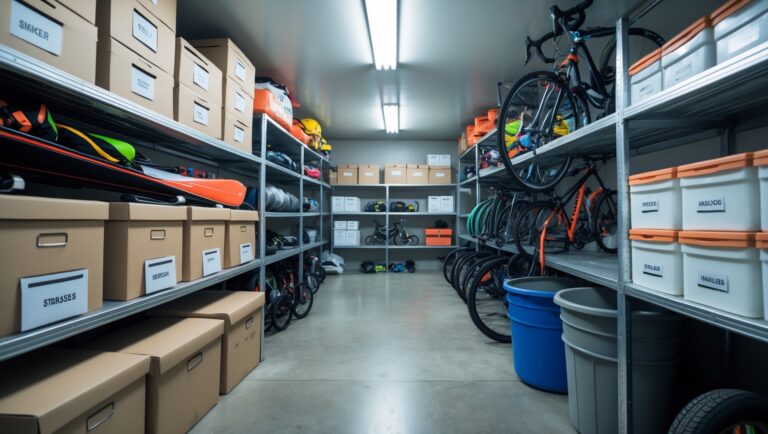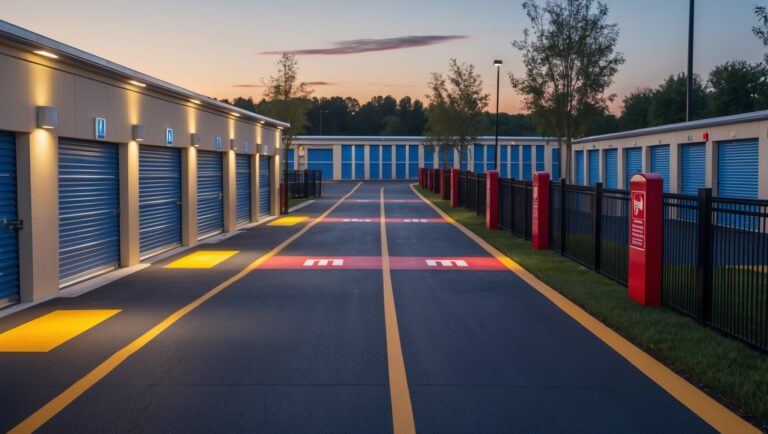Storage Facility Roof Maintenance: Preventing Leaks and Extending Lifespan
Introduction
The roof is the first and most critical line of defense for any storage facility. It protects valuable customer belongings and expensive infrastructure from the elements, yet roof maintenance is often overlooked until a leak or major problem develops. For owners and operators, a neglected roof can quickly lead to costly repairs, insurance claims, water-damaged inventory, and even lost business from dissatisfied renters. In contrast, proactive roof care can extend the facility’s lifespan, minimize operational disruptions, and safeguard your reputation. This comprehensive guide provides in-depth, actionable strategies for storage facility roof maintenance, focusing on leak prevention and maximizing your roofing investment. Whether you manage older buildings or oversee modern metal-roofed complexes, these expert tips will help you avoid common pitfalls, recognize early warning signs, and establish a robust roof care routine tailored to the unique challenges of moving and storage properties.
Understanding Storage Facility Roof Types
Common Roofing Materials Used in Storage Facilities
- Metal Roofs: Favored for their durability, fire resistance, and low maintenance, metal roofs are prevalent in modern self-storage construction. However, they require attention to seams, fasteners, and rust prevention.
- Single-Ply Membranes (TPO/PVC/EPDM): Popular for flat or low-slope commercial roofs, these membranes offer excellent waterproofing but can be vulnerable to punctures and UV degradation.
- Asphalt Shingles: Sometimes used on older or converted facilities, asphalt shingles are affordable but may deteriorate quickly under extreme weather conditions.
- Built-Up Roofing (BUR): Multi-layered systems using bitumen and reinforcing fabrics, BUR offers redundancy but can be heavy and complex to repair.
How Roof Design Impacts Maintenance Needs
- Flat Roofs: Require frequent drainage checks and membrane inspections to prevent pooling and leaks.
- Pitched Roofs: Better at shedding water and debris but require attention to flashing, valleys, and gutter systems.
The True Cost of Roof Neglect
Direct Financial Impacts
- Leak-Related Repairs: Water intrusion can damage ceilings, insulation, and stored goods, leading to expensive emergency fixes.
- Insurance Claims and Premiums: Frequent claims may increase premiums or even risk policy non-renewal.
- Lost Revenue: Units affected by leaks may become unrentable, eroding your facility’s bottom line.
Indirect and Long-Term Risks
- Mold and Mildew: Chronic moisture encourages mold growth, which can spread rapidly and pose health risks.
- Structural Damage: Persistent water ingress weakens the building envelope, potentially leading to major capital expenditures.
- Reputation Damage: Negative reviews and word-of-mouth can deter prospective renters.
Establishing a Proactive Roof Maintenance Plan
1. Routine Inspections
- Frequency: Conduct full roof inspections at least twice a year—ideally in spring and fall—and after major weather events.
- Inspection Checklist:
- Look for rust, corrosion, or missing fasteners on metal roofs.
- Check for membrane punctures, shrinkage, or uplift on flat roofs.
- Inspect flashing, seams, and roof penetrations (vents, HVAC units, skylights).
- Examine gutters, downspouts, and drainage systems for obstructions.
- Assess for ponding water, debris accumulation, and signs of animal activity.
2. Preventive Maintenance Tasks
- Debris Removal: Regularly clear leaves, branches, and trash to prevent blocked drainage and standing water.
- Sealant and Flashing Updates: Reapply or replace deteriorated caulks and sealants, especially around penetrations and seams.
- Rust Treatment: Use rust-inhibiting primers and paints on exposed metal components.
- Gutter and Downspout Cleaning: Maintain free-flowing drainage to avoid overflow and water backup onto the roof.
3. Professional Assessments
- Engage a qualified roofing contractor for annual inspections and whenever significant issues are detected.
- Request photographic documentation and detailed reports for your maintenance records.
Recognizing Early Warning Signs of Trouble
Inside the Facility
- Water stains or discoloration on ceilings and upper walls.
- Mildew odors, dampness, or visible mold in affected units.
- Unexplained increases in humidity or rust on stored items.
On the Roof Surface
- Blistering, cracking, or bubbling on membrane roofs.
- Loose, missing, or corroded fasteners and seams on metal roofs.
- Sagging or uneven roof lines, indicating underlying structural issues.
- Accumulated water that does not drain within 48 hours after rainfall.
Common Leak Sources in Storage Facilities
- Seam Failures: Poorly installed or aged seams can separate, especially on metal and membrane roofs.
- Punctures and Tears: Foot traffic, falling branches, or maintenance tools can compromise roof integrity.
- Flashing Deterioration: Exposed flashing around vents and edges is a frequent entry point for water.
- Clogged Drains and Gutters: Water backs up onto the roof when drainage systems are blocked.
- Fastener Back-Out: Vibrations, temperature changes, and building movement can loosen screws or bolts.
Best Practices for Leak Prevention
Material-Specific Strategies
- Metal Roofs:
- Use high-quality, UV-resistant sealants at seams and fasteners.
- Install foam closure strips to block wind-driven rain and pests.
- Ensure proper overlap and alignment during repairs or replacement.
- Single-Ply Membrane Roofs:
- Limit roof access to trained personnel to prevent accidental damage.
- Apply protective walkway pads in high-traffic areas.
- Patch punctures promptly using compatible membrane materials.
- Shingle Roofs:
- Replace cracked, curled, or missing shingles immediately.
- Re-nail or re-seal lifted or loose flashing components.
Drainage and Water Management
- Maintain a minimum roof slope for flat roofs (typically 1/4 inch per foot) to promote proper drainage.
- Install and maintain scuppers, internal drains, and overflow outlets as needed.
- Inspect gutters and downspouts after storms and at least quarterly.
Vegetation and Debris Control
- Trim overhanging trees to prevent falling branches and excessive leaf buildup.
- Discourage moss and algae growth with appropriate chemical treatments or zinc strips.
When to Repair Versus Replace
Evaluating Roof Age and Condition
- Most commercial metal roofs last 30-50 years with proper care; single-ply membranes typically last 15-25 years.
- Frequent leaks, widespread rust, or persistent ponding may indicate it’s time for replacement.
Cost-Effective Repair Strategies
- Prioritize repairs for active leaks and critical seams.
- Consider partial replacement or overlays if the roof structure is sound.
- Always address the underlying cause, not just the symptoms.
Record-Keeping and Warranty Considerations
- Maintain detailed logs of all inspections, repairs, and maintenance activities.
- Store warranty documents and contractor reports in a centralized, accessible location.
- Understand the terms of your roof warranty—some require regular professional inspections to remain valid.
Integrating Roof Maintenance Into Facility Operations
Staff Training and Awareness
- Train staff to recognize and promptly report roof-related issues.
- Establish clear protocols for responding to leaks or storm damage.
Emergency Response Planning
- Develop an action plan for leaks, including tenant notification, unit relocation, and rapid containment.
- Keep emergency repair materials on site (tarps, sealants, sandbags).
Partnering With Professional Roofers
- Select contractors experienced with commercial and storage facility roofing systems.
- Request references and verify licensing, insurance, and safety record.
- Consider a maintenance contract for regular inspections and priority service during emergencies.
Future-Proofing: Upgrades and Innovations
- Cool Roof Coatings: Reflective coatings reduce heat absorption, lower cooling costs, and extend roof life.
- Integrated Roof Sensors: New technologies can monitor for leaks, moisture, and temperature changes in real time.
- Sustainable Materials: Consider upgrades to longer-lasting or recycled roofing products during major renovations.
Conclusion
The roof may be out of sight, but it should never be out of mind for storage facility owners and managers. Prioritizing roof maintenance is not just about avoiding leaks—it’s about ensuring the security of your customer’s belongings, preserving your facility’s value, and reducing preventable expenses. By understanding your roof type and vulnerabilities, implementing a structured inspection schedule, addressing minor issues before they escalate, and partnering with trusted professionals, you can transform roof care from a reactive chore into a strategic advantage. This approach extends the lifespan of your investment and enhances your reputation in a competitive market. Remember: a well-maintained roof is the silent partner to your facility’s success. Make roof maintenance a core pillar of your operational plan, and your customers—and your bottom line—will thank you for years to come.






